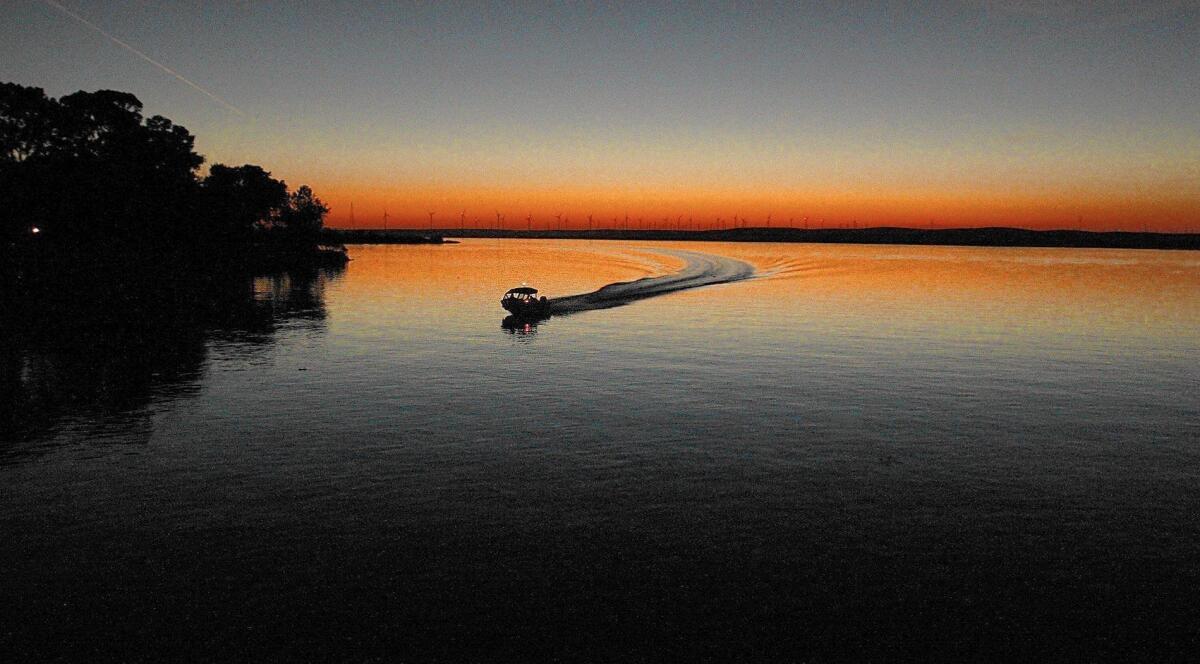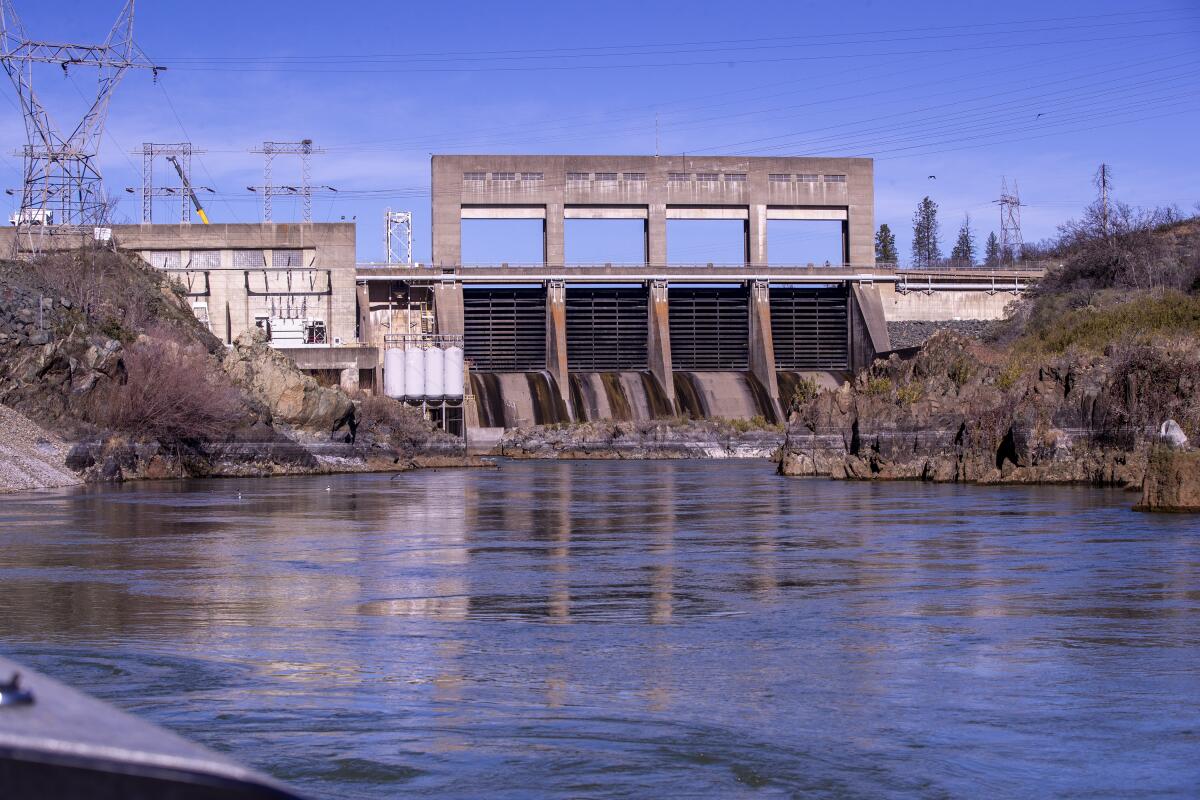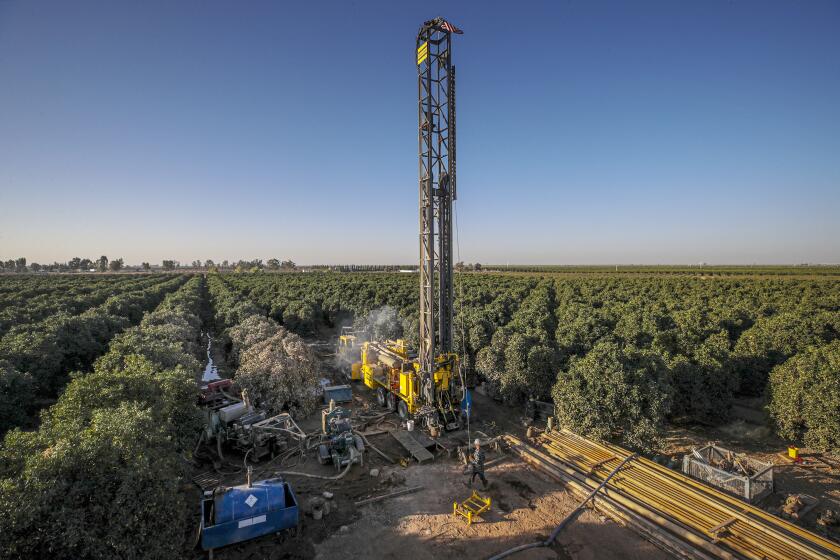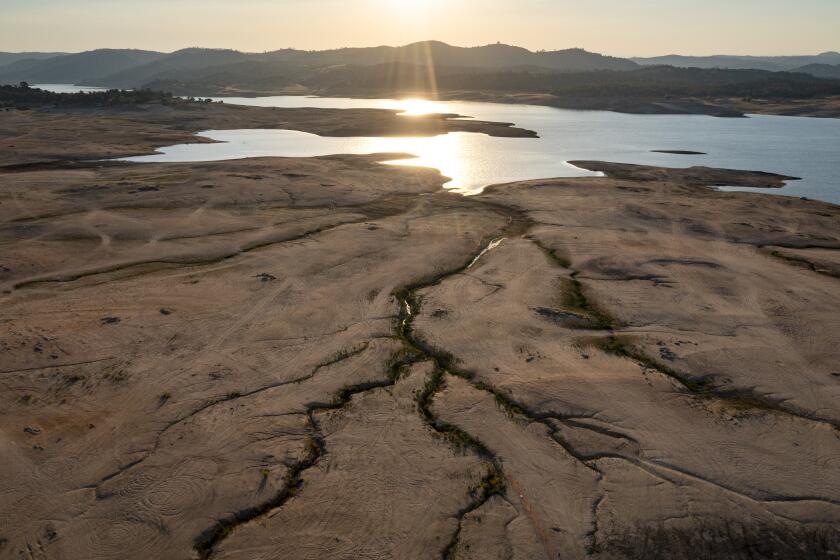California says $2.6-billion pact can protect delta amid drought. Critics disagree

- Share via
It’s a major source of California’s water supply and a vital habitat for fish, migratory birds and other species.
But the Sacramento-San Joaquin River Delta watershed is also a fragile ecosystem in decline, with human demands for water taking a harsh toll on the environment.
With a third year of severe drought straining water resources and pushing endangered salmon and other fish closer to extinction, California officials have announced a controversial $2.6-billion deal with the federal government and major water suppliers that they say will bolster the ecosystem.
The new pact, called a memorandum of understanding, reflects a realization that with climate change, “the system is collapsing quicker than the laws and regulations that exist can manage or heal that system,” said Jared Blumenfeld, California’s environmental protection secretary.
Despite a California law intended to end over-pumping of aquifers, a frenzy of agricultural well drilling continues in the San Joaquin Valley.
The proposed agreement lays out plans over the next eight years whereby agencies that supply cities and farms would give up water or secure additional supplies to help threatened species, while state, federal and local agencies would fund projects to improve habitat in the watershed.
State officials called the deal an important milestone in their efforts to balance the delta’s ecological needs with the water needs of Californians, and a key step toward larger “voluntary agreements” that can help ensure substantial flows for the health of the estuary.
Gov. Gavin Newsom declared the plan a historic rejection of “old binaries” in favor of new solutions, while Blumenfeld said it would “move us away from ‘water wars’ of yesteryear.”
Those claims drew strong criticism, however.
Immediately after the plan’s announcement on Tuesday, environmental advocates and salmon conservationists condemned it as a set of backroom deals negotiated out of the public eye that wouldn’t provide nearly enough water for threatened fish or the overall health of the watershed.
“Nothing has been achieved through backroom negotiations with water districts,” said Jon Rosenfield, senior scientist with the group San Francisco Baykeeper. “The state’s latest scheme promises only a tiny fraction of the relief our rivers, fisheries and delta communities need, according to a wealth of research — and it leaves all the hard questions unanswered.”
The San Francisco Bay Delta is the largest estuary on the West Coast. Formed by the convergence of California’s two largest rivers, the Sacramento-San Joaquin Delta lies at the heart of the state’s water system.
Two huge government-run pumping plants draw water from the delta’s southern edge and send it flowing through the canals of the State Water Project and the Central Valley Project, supplying vast farmlands and cities to the south.
The delta’s ecosystem has been ailing for decades, and the export of large quantities of freshwater has been a major reason. Climate change has added to the stresses on the ecosystem by intensifying droughts.
Fish have suffered. The delta smelt is now on the brink of extinction. And endangered winter-run Chinook salmon have struggled to reproduce in the Sacramento River when the water flowing from Shasta Dam has warmed up so much that many eggs fail to hatch.
Gov. Gavin Newsom issued an executive order Monday calling on local water agencies to implement more aggressive water conservation measures.
State officials said the agreement aims to meet water-quality objectives in the Delta through additional flows for the environment, projects that restore and improve thousands of acres of aquatic habitat, and funding to purchase water and carry out habitat projects. They said these projects would include creating more spawning habitat for salmon and smelt, restoring floodplains and side channels, and removing barriers that hinder fish, among other things.
Wade Crowfoot, California’s natural resources secretary, said the steps toward voluntary agreements among water agencies “hold promise to improve environmental conditions more quickly and holistically than regulatory requirements.”
But the plan still needs to be endorsed by the State Water Resources Control Board, which is required to update its water-quality plan for the delta. Heavy criticism of the announcement also suggests Newsom and his administration will face opposition as they continue pushing for voluntary water deals.
The agreement’s signatories included more than a dozen water agencies, among them the Metropolitan Water District of Southern California and Westlands Water District, some of the nation’s largest water suppliers. Water agencies have agreed to provide varying flows, depending on whether conditions are wet, above average, below average, dry or critically dry.
Amounts of water contributed annually by the signatories could range between 150,000 acre-feet to 825,000 acre-feet. The largest amount of water, if spread out across the city of Los Angeles, would cover the area more than 2 feet deep.

Baykeeper’s Rosenfield pointed out that would be much less than the average of approximately 1.5 million to 1.6 million acre-feet that the state water board had contemplated in a 2018 document, and far less than what the board had indicated would be needed to protect imperiled fish in the delta watershed as well as the state’s commercial and recreational fisheries.
Rosenfield and other critics noted that the agreement uses a water baseline laid down in 2019 by the Trump administration, so much of the additional water made available under the proposal would simply restore the flows that had been called for under federal biological opinions a decade earlier.
Rosenfield also criticized provisions of the deal that involve purchasing water for environmental purposes, essentially using taxpayer money to “subsidize” the water districts’ obligations.
“We don’t need to pay water districts for water that belongs to the people of California,” Rosenfield said.
However, state officials stressed that the agreement would send a significant amount of water flowing through the delta that otherwise wouldn’t be helping the ecosystem. And they said the collaborative approach, worked out through years of meetings and negotiations, can avoid protracted fights.
“You can get a lot more done at a bigger scale when you’re trying to do it collaboratively, because you step around what tends to be decades’ worth of litigation, when people don’t want to voluntarily talk about leaving water in the rivers,” said Chuck Bonham, director of the California Department of Fish and Wildlife.
“Instead of fighting about what to do, we now have a commitment for one of the largest habitat restoration efforts conceivable,” Bonham said.
He said large-scale habitat restoration efforts in the watershed can make a big difference in recovering fish and other species that are at risk.
The state’s traditional approach has been to adopt regulations and then deal with lawsuits, and the proposed agreement aims to circumvent that approach to reduce uncertainty, said Jeffrey Mount, a senior fellow with the Public Policy Institute of California.
“For the water user community, it meets one of their great needs, and that is regulatory certainty,” Mount said. “It’s so that there is not an annual, difficult regulatory battle.”
Mount said he supports the approach generally and has been calling for something like this for years as a more effective strategy.
“But it would have been better if they could have actually brought in the environmental community and had them as part of these negotiations,” Mount said.
What will ultimately come out of the plan is uncertain, he said, because some agencies haven’t signed on to the terms and the deal will need to undergo a lengthy review.
The plan laid out in the agreement calls for environmental monitoring, and if key indicators aren’t met through the voluntary agreement by the sixth year, Blumenfeld said, the state could change course and instead work toward those goals through regulation. State regulators could determine if the voluntary agreements should be continued, modified or ended.
“So there’s a backstop,” Blumenfeld said. “There’s a lot at stake to make it work. But if it doesn’t, we get to implement the more traditional regulatory pathway.”
Water districts that do not agree to the voluntary approach will be required to comply with requirements set by the state water board. The agencies that haven’t signed on include those that draw water from the lower San Joaquin River and its tributaries, among them the Merced Irrigation District, Modesto Irrigation District, Friant Water Authority and San Francisco Public Utilities Commission.
State officials have told managers of these agencies that their proposals fall short of what’s needed, and that the door is open for them to participate if they agree to enough additional water and support for habitat projects.
Mount said the state may be taking a “divide and conquer strategy,” but it most certainly won’t end the conflicts.
“The water wars will continue because we’re talking about tradeoffs in use in a zero-sum game,” Mount said.
The water agencies that have joined the deal have committed to restoring or creating 20,000 acres of floodplain habitat, and nearly 3,300 acres of additional habitat where fish can spawn.
A breakdown of the implementation costs under the agreement lists $858 million for habitat restoration and construction in the watershed, plus additional amounts for scientific monitoring, water purchases and payments for some growers to leave farmlands dry and fallow.
Managers of water districts that signed the agreement this week have committed to taking the terms to their boards for endorsement.
Adel Hagekhalil, general manager of the Metropolitan Water District, said the agreement represents a milestone first step in a joint effort to develop a watershed-wide approach to address the challenges in the delta.
“We need to work collaboratively with all of our state, federal, environmental and water agency partners to ensure we have a comprehensive action plan that improves water reliability and delivers real results for the environment,” Hagekhalil said in a statement.
The Newsom administration is pushing for the voluntary deals while also pursuing a controversial plan for rerouting the state’s water system by building a huge water tunnel beneath the delta.
Environmental advocates said they’re concerned about the estimated $2.6 billion that would be spent on implementation, with funds coming from water suppliers and the state and federal governments. They also said that there is no enforcement mechanism if the expected funding doesn’t come through, and that the document outlining the deal counts water supplies that have yet to be secured.
“Of course, we support floodplain restoration,” said Regina Chichizola, executive director of the group Save California Salmon. But she said research has shown that the health of the delta ecosystem demands much more water than this agreement would provide.
“This to me doesn’t seem like it’s dealing with drought or climate change or what the actual needs of [the] delta are. So I’m disappointed,” Chichizola said.
She said it’s also concerning that instead of having an open, democratic process guided by science, “it’s just the most elite water users” that were in the room to negotiate.
John McManus, president of the Golden State Salmon Assn., said that nobody from the salmon fishing industry was invited to participate in the talks.
“I think many in California will wonder why taxpayers have to pay to gain basic environmental protections for our fish and wildlife,” McManus said. “Don’t we already have regulations that should ensure the protection of our fish and wildlife?”
More to Read
Sign up for Essential California
The most important California stories and recommendations in your inbox every morning.
You may occasionally receive promotional content from the Los Angeles Times.













